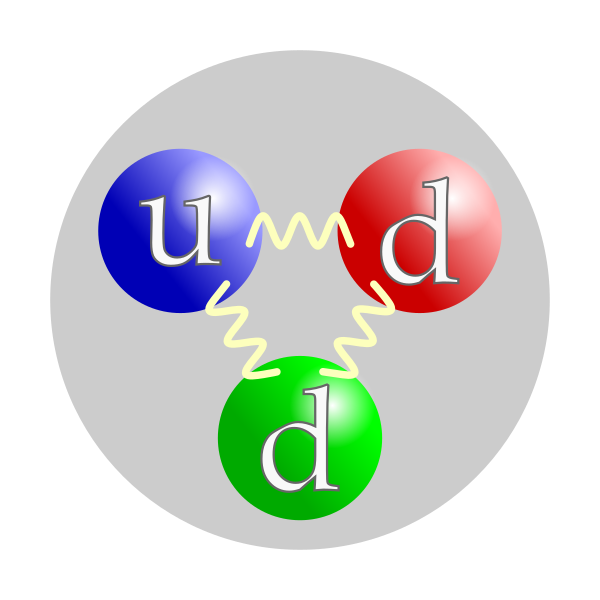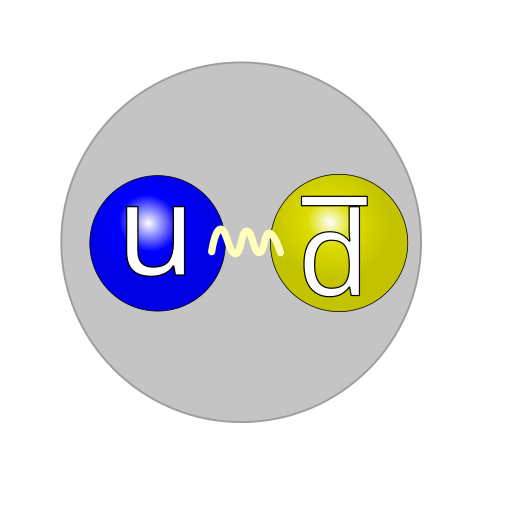OCR Specification focus:
‘Recall charges for u, d, s and their antiquarks as fractions of e; determine hadron charges.’
Quark charges form a fundamental part of particle physics, allowing us to understand how hadrons acquire their overall charge. This section explains essential quark charge values.
Quark Charges in the Standard Model
In the quark model, all hadrons—particles made of quarks—derive their overall electrical charge from the charges of the quarks they contain. OCR requires students to recall the charges for the u, d, and s quarks and their corresponding antiquarks, and then use these values to determine the charges of hadrons such as protons, neutrons, and mesons. Quark charges are always expressed as simple fractions of the elementary charge, denoted e, which is the magnitude of the charge carried by a proton.
Fundamental Quarks and Their Importance
The three quarks specified at A-Level—up (u), down (d), and strange (s)—belong to the family of light quarks, those that form the majority of observable matter. They combine in various ways to produce different hadrons. These quarks are considered fundamental particles, meaning they have no known internal structure. Each quark also has a corresponding antiquark, which has the same mass but opposite charge.
The Role of Charge in Particle Structure
Charge is a crucial quantum property that helps determine how quarks interact through the electromagnetic force. When quarks combine, their charges simply add together, leading to the familiar charges seen in everyday composite particles. For example, the total charge of a proton emerges from the sum of the charges of the quarks that form it.
Introducing the key charge values requires attention to accuracy and clarity, as these fractional charges represent quantised physical properties central to particle classifications.
Elementary charge (e): The fundamental unit of electric charge, equal to the magnitude of the charge on a proton.
These fractional quark charges, although unusual compared with everyday integer charges, are fully supported by experimental evidence and form the basis of the Standard Model’s internal structure of matter.
Quark and Antiquark Charge Values
OCR expects students to memorise the charges of the u, d, s quarks and their antiquarks.
These values are fixed and appear in all applications of the quark model.
Charges of Quarks
Each of the three quarks covered at this level has a specific fractional charge:
Up (u): +2⁄3 e
Down (d): −1⁄3 e
Strange (s): −1⁄3 e
Charges of Antiquarks
Antiquarks carry opposite signs to their quark counterparts:
Anti-up (ū): −2⁄3 e
Anti-down (đ̄): +1⁄3 e
Anti-strange (s̄): +1⁄3 e
These fractional charges are central to determining the structure and classification of both baryons (such as protons and neutrons, made of three quarks) and mesons (quark–antiquark pairs).
Determining Hadron Charges from Quark Content
Students must be able to calculate the overall charge of a hadron by adding the charges of its constituent quarks. The calculation is straightforward, using the charge values already listed. This method of determining charge confirms internal particle structure and matches experimental observations.
Baryons
Baryons contain three quarks.

This diagram shows a neutron composed of one up quark and two down quarks bound by gluons. It illustrates that baryons consist of three quarks and that the total charge results from summing the fractional quark charges, giving zero for the neutron. The gluon links and colour-coded spheres suggest the strong interaction, extending slightly beyond the syllabus but remaining accurate. Source.
Their total charge is the arithmetic sum of the three constituent quark charges. OCR specifically requires knowledge of the proton and neutron quark content from a separate subsubtopic, but the mechanics of charge determination lie within this section.
When applying charge addition, it is helpful to present the process as a structured sequence:
Identify the quark composition of the baryon.
Write down the charge of each quark using fractional e notation.
Add the quark charges algebraically to obtain the total charge.
Express the final result using multiples of e.
Mesons
Mesons are formed from one quark and one antiquark, meaning one uses both the quark and antiquark charge lists.

This diagram represents a positive pion (π⁺) composed of an up quark and an anti-down quark. It demonstrates the meson structure as a quark–antiquark pair and reinforces that antiquarks have charges opposite to their quark counterparts. The visual inclusion of colour charge and gluons goes beyond OCR requirements but remains accurate and helpful context. Source.
The contrasting signs are significant, as antiquark contributions often cancel or offset quark charges. The procedure mirrors that used for baryons but includes careful application of the antiquark charge conventions.
Charge Conservation and Particle Interactions
When quark compositions change—for example, during particle decays—the conservation of charge is always upheld. This means the sum total of all charges before and after an interaction must remain identical. Quark charges ensure that this conservation principle works at the subatomic level.
Charge conservation: A fundamental principle stating that the total electric charge in any isolated system remains constant during all physical processes.
Charge conservation provides a powerful consistency check when studying or constructing decay equations and reaction processes in later topics.
Using Quark Charges in OCR Examinations
OCR often requires students to:
Recall and quote quark and antiquark charges.
Determine the charge of a hadron from its quark composition.
Verify charge conservation in particle transformations.
Interpret whether proposed particle compositions are physically valid.
To support these tasks, students must confidently manipulate fractional charges and consistently apply them within the quark model framework. Mastery of quark charges enables accurate classification of particles and strengthens conceptual understanding of how fundamental particle properties give rise to the observable characteristics of matter.
FAQ
Fractional charges arise naturally from the mathematics of the Standard Model, particularly from how quarks fit into symmetry groups that describe fundamental interactions.
These fractional values are not arbitrary; they ensure that combinations of quarks produce the whole-number charges observed in stable particles.
For example, combining three quarks in baryons or a quark–antiquark pair in mesons always leads to integer multiples of the elementary charge.
No isolated quark with a fractional charge has ever been observed, reinforcing the idea that fractional charges only appear inside composite particles.
Quark charges affect more than just the basic hadron groupings; they influence how particles are further categorised within multiplets such as isospin doublets or flavour families.
For example:
• Up and down quarks form an isospin doublet due to their similar masses and related charges.
• Strange quarks introduce additional multiplet structures within the baryon octet and decuplet.
These classifications help physicists predict particle interactions and decay patterns using symmetry principles.
Antiquarks arise from the requirement that every particle in quantum field theory has an associated antiparticle with opposite quantum numbers.
Charge reversal is a fundamental property: electric charge changes sign under charge conjugation, while mass does not.
This ensures symmetry between matter and antimatter and allows processes such as particle–antiparticle annihilation to conserve physical quantities.
Antiquarks therefore behave like mirror counterparts to quarks in electromagnetic interactions but respond identically under gravity.
Quark charge combinations act as a diagnostic tool when identifying unknown particles.
Physicists analyse:
• Whether the total charge can be produced from a known set of quark combinations (e.g., qqq or q q̄).
• Whether more unusual combinations such as tetraquarks (qq q̄ q̄) or pentaquarks (qqqq q̄) are required.
If a particle’s measured charge cannot be explained by standard baryon or meson compositions, it may indicate an exotic hadron structure.
Colour charge and electric charge are distinct properties carried by quarks, linked to different fundamental forces.
Electric charge governs electromagnetic interactions and determines how quarks contribute to the charge of hadrons.
Colour charge governs the strong interaction and binds quarks together through gluon exchange.
Although both properties influence quark behaviour, they operate independently: electric charge affects long-range electromagnetic forces, while colour charge confines quarks within hadrons and never appears in isolation.
Practice Questions
Question 1 (2 marks)
State the electric charge of:
(a) a down quark
(b) an anti-up quark
Question 1 (2 marks)
(a) Down quark has charge −1/3 e.
• 1 mark for −1/3 e
(b) Anti-up quark has charge −2/3 e.
• 1 mark for −2/3 e
Question 2 (5 marks)
A particle is proposed to have the quark composition u s̄ d.
(a) Using quark charges, determine the total charge of this particle.
(b) Explain whether this quark combination could represent a baryon or a meson.
(c) Comment on what the calculated charge suggests about how this particle might behave in electromagnetic interactions.
Question 2 (5 marks)
(a) Charge calculation (3 marks total)
• Up quark charge = +2/3 e (1 mark)
• Strange antiquark charge = +1/3 e (1 mark)
• Down quark charge = −1/3 e; sum = +2/3 e (1 mark)
(b) Particle classification (1 mark)
• Must state that u s̄ d cannot be a baryon or a meson; baryons require 3 quarks, mesons require quark–antiquark only.
(1 mark)
(c) Electromagnetic behaviour (1 mark)
• Because the total charge is +2/3 e, the particle would interact electromagnetically, experiencing attraction/repulsion and producing or responding to electromagnetic fields.
(1 mark)

